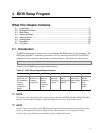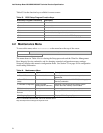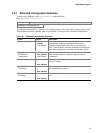
Intel Desktop Board D810EMO/MO810E Technical Product Specification
66
3.6 Recovering BIOS Data
Some types of failure can destroy the BIOS. For example, the data can be lost if a power outage
occurs while the BIOS is being upgraded in flash memory. The BIOS can be recovered from
either a 1.44 MB diskette (for recovery from an LS-120 diskette drive configured as an ATAPI
removable IDE device) or from a CD-ROM (for use in an ATAPI CD-ROM drive) using the BIOS
recovery mode. When recovering the BIOS, be aware of the following:
• Recovery requires the use of bootable media in a bootable device.
• Because of the small amount of code available in the nonerasable boot block area, there is no
video support. You can only monitor this procedure by listening to the speaker or looking at
the recovery drive LED.
• Two beeps indicate the beginning of the BIOS recovery process.
• Two beeps and the end of activity in the recovery drive indicate successful BIOS recovery.
• A series of continuous beeps indicates a failed BIOS recovery.
BIOS recovery media can be either a 1.44 MB diskette or a CD-ROM. The recovery media must
be bootable and it must contain the BIOS update files copied to it. BIOS upgrades and the Intel
Flash Memory Upgrade utility are available from Intel Customer Support through the Intel World
Wide Web site.
✏
NOTE
BIOS recovery cannot be accomplished using non-SPD DIMMs. SPD data structure is required
for the recovery process.
✏
NOTE
If the computer is configured to boot from an LS-120 diskette (in the Boot menu), the BIOS
recovery diskette must be a standard 1.44 MB diskette not a 120 MB diskette.
For information about Refer to
The BIOS recovery mode Section 2.9, page 49
The Boot menu in the BIOS Setup program Section 4.7, page 85
Contacting Intel customer support Section 1.2, page 13


















